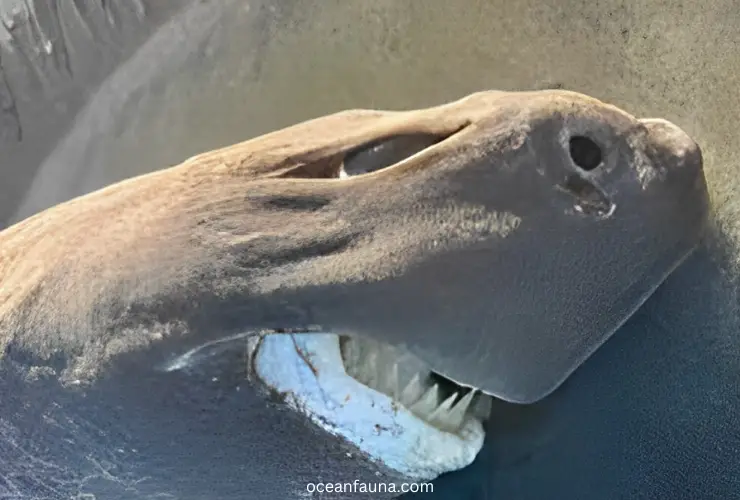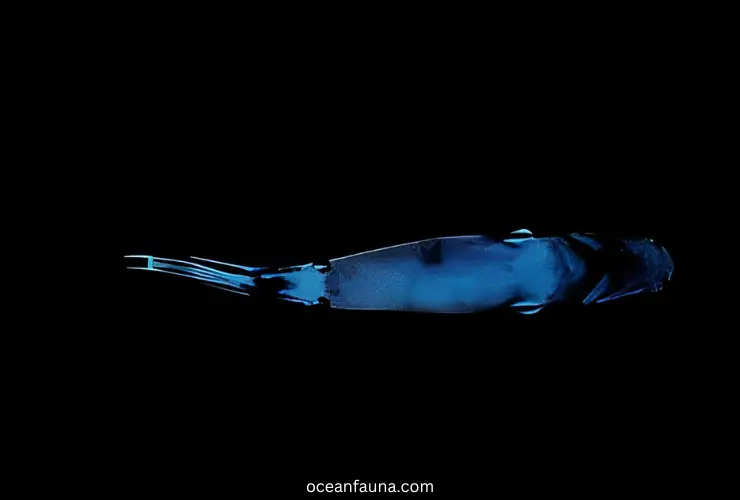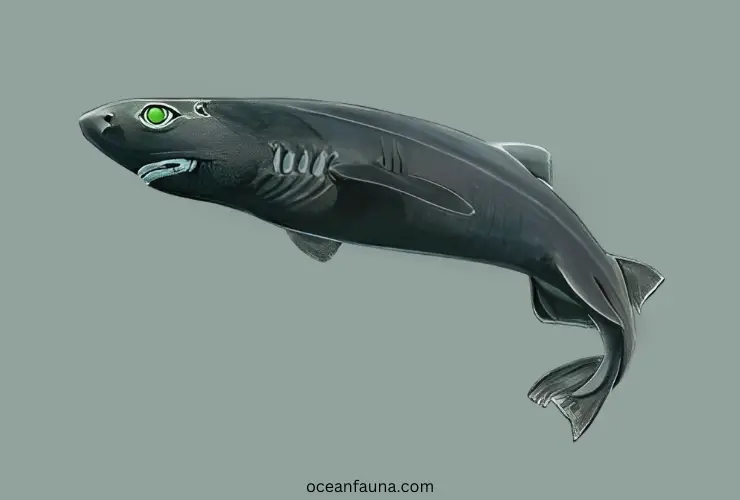Kitefin Sharks are also known as seal sharks. They belong to the family of Dalatiidae and are distributed in temperate waters worldwide. They are habitat mostly at an ocean depth of 200-600 meters.
So many amazing facts are out there about these sharks. In this article, I will discuss everything in detail.
About: Kitefin Shark
| Category | Information |
| Common Name | Kitefin Shark |
| Scientific Name | Dalatias licha |
| Family | Dalatiidae |
| Size | Up to 1.8 meters (6 feet) long and weigh up to 91 kg (200 pounds) |
| Diet | Carnivorous, feeding mainly on deep-sea fish and squid |
| Habitat | Deep sea, typically found between 200-600 meters |
| Reproduction | Oviparous (lay eggs) |
| Litter Size | 10-16 pups |
| Lifespan | 18.4 years |
| Conservation Status | “Vulnerable” according to the IUCN Red List |
The Kitefin Shark (Dalatias licha) is an ancient shark species that dates back to the Eocene epoch, some 40 million years ago. It belongs to the Dalatiidae family and is believed to be one of the oldest living shark species in existence today.
These predators have a unique physical appearance, with an elongated and diamond-shaped body that can reach around 5-6 feet in length.
They feature a unique set of fin shapes, consisting of a dorsal fin placed far forward on their bodies, pelvic fins located behind the gills, and anal fins positioned near their tail fin. Kitefin Sharks feed primarily on smaller fish and squid, using their powerful jaws to catch prey as they swim through the depths of the ocean.
Kitefin Sharks inhabit a wide range of oceanic waters worldwide, commonly found in temperate or tropical regions like the Atlantic Ocean near North Carolina or Mexico. They typically prefer deep waters where sunlight cannot reach them, usually between 200-600 meters below sea level.
Kitefin Sharks display remarkable adaptations for surviving in these depths, such as large eyes to help them see better during darkness and specialized organs for detecting chemicals in water for locating food sources or potential mates.
This species is also believed to be highly migratory since it has been recorded moving thousands of miles across open oceans during its lifetime.
Fun Facts: Kitefin Sharks
- Kitefin sharks, also known as Dalatias Licha, are found in deep waters around the world, usually at depths of 200-600 meters.
- They are named after their unique kite-shaped fins, which are elongated and pointed, helping them move quickly through the water.
- Kitefin sharks can grow up to 6 feet in length.
- They glow with blue-green light in the dark.
- They are known to be nocturnal, meaning they are most active at night.
- Unlike most other sharks, kitefin sharks have a very slow metabolism and can go for long periods without food.
- Their unique jaw structure allows them to eat large prey, such as squids, octopuses, and other sharks.
- Kitefin sharks have been known to attack and eat other sharks, including blue sharks and even their own kind.
- Despite their fierce reputation, kitefin sharks are not considered a significant threat to humans, as they rarely come into contact with people.
- The International Union for Conservation of Nature (IUCN) has identified these species as “Vulnerable” on their Red List of Threatened Species.

Anatomy of Kitefin Sharks
Kitefin shark has distinct torpedo-shaped body with blunt snout and large eyes, giving them an almost comical appearance. Despite their average small size, they are incredibly well adapted to the marine environment and have several specialized anatomical features that enable them to survive and thrive in the deep sea.
Skeletal System
The kitefin shark has a cartilaginous skeleton that is lightweight yet durable which helps them move quickly through the water. The skeleton consists of many vertebrae, which allow for flexible movement in all directions, along with two dorsal fins, two pectoral fins, two pelvic fins, and an anal fin.
Muscular System
Kitefin sharks possess powerful muscles that enable them to swim swiftly through the water. The muscles are arranged in layers along the body and include white muscle for quick bursts of speed and red muscle for sustained swimming.
They also contain retractor muscles surrounding their pectoral fins which can be used to reduce drag when swimming at high speeds.
Nervous System
The nervous system of kitefin sharks is composed of a brain, spinal cord, nerves, and receptors that enable it to react quickly and accurately to its surroundings. The brain contains centers responsible for controlling movement, senses such as sight and smell, memory retention, migration patterns, reproduction, and social behavior.
Additionally, special cells called electroreceptors allow the shark to sense electrical impulses from other animals in its environment.
Digestive System
The digestive system of kitefin sharks is quite specialized as they feed mainly on smaller prey items like fish or squid. Their short intestines contain several enzymes that help break down food particles into smaller molecules so they can be absorbed into the bloodstream for energy production.
In addition, their stomachs secrete acids that aid in digestion by breaking down tough material, such as shells or bones, from larger prey items, before passing it through their intestines for further processing.
Circulatory System
Kitefin sharks have an efficient circulatory system consisting of two separate pumps; one for oxygenated blood and one for deoxygenated blood.
Blood containing oxygen flows from their gills directly into their ventricles before being sent out throughout their bodies via arteries, while deoxygenated blood returns back to their hearts via veins, where it then receives more oxygen before repeating the cycle.
This allows them to regulate their body temperature efficiently as well as deliver oxygen-rich blood throughout their bodies when diving deep underwater where there is less dissolved oxygen available in the water column itself.
Respiratory System
Like all other elasmobranchs (sharks), kite fins use gills to absorb dissolved oxygen from seawater so they can breathe underwater without having lungs or regular breathing mechanisms like mammals do on land (although they occasionally need to surface).
Their five pairs of gill slits located just behind each eye draw in seawater which flows over internal filaments where tiny capillaries extract oxygen before being expelled back out through the gills once again, allowing this process to repeat continuously while swimming forward without interruption.
What Do Kitefin Sharks Eat?
Kitefin sharks are voracious predators and have a varied diet. They consume a wide variety of small deepwater fishes, including skates and other species of sharks, in addition to squids and octopods, shrimps and lobsters, isopods and amphipods, siphonophores, and polychaetes.
Fishes make up the majority of their diet, but they also feed on cephalopods such as cuttlefish and squid. In addition to this array of invertebrates, they may also eat bony fish like mackerels, herring, and tuna.
The kitefin shark has an elongated head with eyes positioned toward the front, allowing them to detect prey more quickly than other sharks.
Their large serrate teeth make them formidable hunters that can easily tear through prey’s flesh. Kitefin sharks are known for using their powerful jaws to sever large chunks of flesh from their prey before consuming it in one bite.
They typically hunt at depths greater than 200 meters where there is little light, utilizing their ability to detect faint electrical signals generated by their prey to locate food sources more quickly.
Where Do Kitefin Sharks Live?
Kitefin sharks live in deep waters of the Atlantic and Mediterranean oceans. They are found from Georges Bank off the east coast of Florida, in the northern Gulf of Mexico, and off the southern Bahamas in the western Atlantic Ocean.
In the eastern Atlantic, they are found from the North Sea southward to Cameroon, including the western Mediterranean Sea. They prefer depths between 200-600 meters below sea level where sunlight cannot reach them.
The kitefin shark can be found mainly in continental shelf habitats and submarine canyons, where they tend to feed on bony fishes and cephalopods such as squid, cuttlefish, and octopus.
These sharks live solitary lives but sometimes gather in groups for mating or hunting opportunities. Kitefin sharks have been known to migrate short distances seasonally, likely seeking more food sources as well as warmer water temperatures during winter months.
The preferred water temperature range for these sharks is between 12-18°C. They can be found both on the bottom of the ocean and in midwater, making them extremely adaptable predators.

What Is Unique about the Kitefin Shark?
The kitefin shark has several unique adaptations that make them well-suited for deepwater environments. They have an elongated body shape, giving them a low drag coefficient in water and making it easier to swim at higher speeds and navigate through tight spaces.
Their eyes are specially adapted for low light conditions, allowing them to see in the ocean’s murky depths. Their large serrate teeth, which are arranged into multiple rows, give them a powerful bite and make it easier for them to tear chunks of flesh from their prey.
The kitefin shark’s most unique adaptation is its electrical sensing system. This species has two small organs on the head known as the Lorenzini ampullae, allowing them to detect faint electrical signals generated by their prey. This helps them locate food sources more quickly, even in low-light conditions.
The most interesting thing is they glow in the dark. The kitefin shark emits a blue-green light that divers can see. This is believed to help them communicate with each other and attract mates. Kitefin Shark is often called the world’s largest-known luminous vertebrates.
What Is the Lifespan of Kitefin Sharks?
The lifespan of kitefin sharks is estimated to be around 18.4 years. This makes them one of the longest-living species of shark, on par with their close relatives, the Greenland shark (Somniosus microcephalus).
Kitefin sharks reach sexual maturity at a size somewhere between 2.5 and 4 feet (0.77-1.21 m) and may live for more than two decades in the wild, depending on the location and their environment.
While most sharks tend to age rapidly and have shorter lifespans, kitefin sharks may experience slower rates of aging due to their larger size, allowing them to live longer than other species.
How Do Kitefin Sharks Reproduce?
Kitefin sharks reproduce via a process known as ovoviviparity. The female kitefin shark will produce several eggs, fertilized in her uterus and then incubated until birth. During this time, the mother nourishes the developing embryos through a placenta-like structure.
When the young are ready to emerge, they are born fully developed and able to fend for themselves immediately. Generally, each clutch consists of 10-16 young, each measuring around 12 inches (30 cm) in length at the time of birth.
Young kitefin sharks may remain with their mother until they are large enough to be independent and form their own territories.

Are Kitefin Sharks Dangerous to Humans?
No, kitefin sharks are not considered to be dangerous to humans. This is due to their small size, deepwater habitat, and lack of documented attacks on humans. Kitefin sharks typically inhabit depths between 200 and 600 meters, so the chance of a human encountering one is extremely low.
Additionally, they typically feed on other fish that are much smaller than themselves. Therefore, there is no reason to believe that these creatures would pose any threat to humans.
What Is the Conservation Status of Kitefin Sharks?
The kitefin shark s listed as Vulnerable on the International Union for Conservation of Nature’s (IUCN) Red List of Threatened Species. This species is facing a high risk of extinction due to the combined effects of overfishing and climate change.
They are caught as bycatch in gillnet fisheries that target other fish species, and they have slow reproductive rates, which make them especially vulnerable to overexploitation. In addition, they are likely impacted by climate-driven changes in ocean temperature and acidity, which can affect their habitat and food supply.
To ensure the long-term survival of this species, fishing practices must be managed responsibly to reduce accidental catch and mortality of juveniles. Fishery management should consider closing areas where kitefin sharks are known to be present during periods when juvenile sharks are present.
In addition, more research should be conducted into how climate-driven changes in ocean conditions might impact this species to better understand their needs and develop effective management strategies.
Finally, increasing public awareness about kitefin sharks could help improve conservation efforts by raising their profile amongst decision-makers and inspiring citizens to act for their protection.
Conclusion
In this article, I have discussed almost everything in detail about kitefin sharks. I have covered everything from their physical characteristics to their conservation status.
Kitefin sharks are a fascinating species that inhabit many of the world’s oceans and seas but remain largely unknown due to their deepwater habitats. If you have any queries about this shark, just let me know.


1 thought on “Kitefin Shark: Anatomy, Diet, Habitat & Facts”